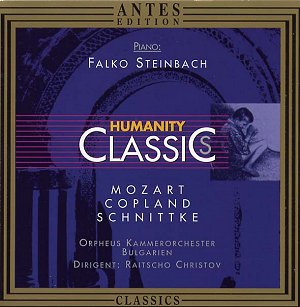A unique coupling.
Quite a strange one, too. One could
argue that the Mozart and Copland are
linked by their zest for life (although
see comments on the performance of the
Mozart below); quite where the Schnittke
fits in is anybody’s guess.
Mozart’s seventeenth
piano concerto is in one of that composer’s
‘open’ keys. There is an endless optimism
in this music, a never-ending freshness
that is almost invincible. Almost. Falko
Steinbach and the Bulgarian Orpheus
Chamber Orchestra give an account that
is thoroughly old-style, completely
free of any informed historical musicology.
Textures are thick, tempi stodgy (the
reverb on the recording hardly helps).
Steinbach has prepared the piano part
well, so that scales are neat enough
and his own cadenza to the first movement
is stylish and carefully thought through.
His cadenza in the second movement (which
almost acts as a second slow movement,
alas) is interesting, managing to be
restful yet harmonically interesting
at the same time. But the slow movement
itself emerges as something one might
hear on a cheap compilation sold near
the checkout of a major supermarket,
far too soupy and syrupy, and intended
merely as background music. The finale
begins well (apoggiaturas nice and chirpy!),
but it becomes sleepy all too soon.
Perhaps the Copland
was chosen for its sleepier sections,
for the Bulgarian Orpheus Chamber Orchestra
do them very well. The more animated
music is nice and pointed, however,
and rhythms become more sprung as a
freshness enters the playing. More likely
that the Copland was chosen to act as
a bridge between the Mozart and the
Schnittke, then. For the Schnittke there
are two preferable choices: English
Symphony Orchestra/Boughton on Nimbus
NI1582, or Chandos CHAN9359 (with the
Royal Stockholm Philharmonic Orchestra
under Gennadi Rozhdestvensky), both
in better couplings. In a sense it is
a pity that the competition is so hot,
as the Schnittke represents the best
of the present Antes disc. The players
convey the rapidly shifting moods of
the first movement well and the second
movement (for violin and piano alone)
is eloquent and lyrical. The rhythmically
alive finale has a musical argument
that is fascinating to follow. But it
is all too little too late. It would
be difficult to recommend this disc
at any price.
Colin Clarke
